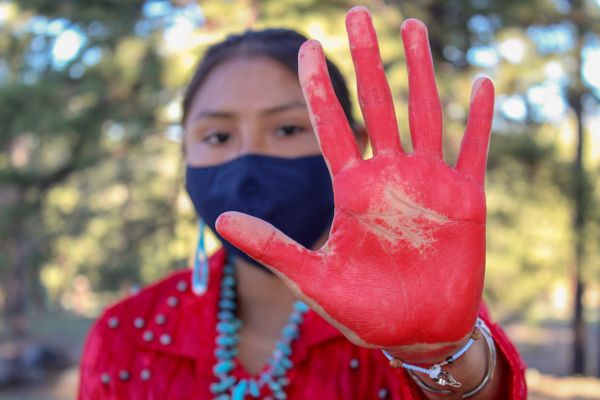 |
graves of children at Carlisle Indian Industrial School
|
NOTE: I've been to Carlisle to see what is left of that school. I've been to Jim Thorpe, PA where the Olympic Athlete is still buried. Nothing, no words, no building or a gravesite can bring back the millions and millions who were murdered on this soil... The colonizer's goal of genocide was a success, by also burying the truth...Trace
President
Joe Biden designated a national monument at a former Native American
boarding school site in Pennsylvania to commemorate the resilience of
tribes whose children were forced to attend the school and similar
abusive institutions
HARRISBURG, Pa. -- President Joe Biden designated a national monument at a former Native American boarding school in Pennsylvania on Monday to honor the resilience of Indigenous tribes whose children were forced to attend the school and hundreds of similar abusive institutions.
The
creation of the Carlisle Federal Indian Boarding School National
Monument — announced during a tribal leaders summit at the White House —
is intended to confront what Biden referred to as a “dark chapter” in
the nation's history.
“We're
not about erasing history. We're about recognizing history — the good,
the bad and the ugly,” Biden said. “I don't want people forgetting 10,
20, 30, 50 years from now and pretend it didn't happen.”
Thousands
of Native children passed through the notorious Carlisle Indian
Industrial School between 1879 and 1918, including Olympian Jim Thorpe.
They came from dozens of tribes under forced assimilation policies that
were meant to erase Native American traditions and “civilize" the
children so they would better fit into white society.
It
was the first school of its type and became a template for a network of
government-backed Native American boarding schools that ultimately
expanded to at least 37 states and territories.
“About
7,800 children from more than 140 tribes were sent to Carlisle — stolen
from their families, their tribes and their homelands. It was wrong
making the Carlisle Indian school a national model,” Biden told the
White House summit.
Thorpe's
great-grandson, James Thorpe Kossakowski, called Biden's designation an
important and “historic” step toward broadening Americans'
understanding of the federal government's forced assimilation policy.
“It's
very emotional for me to walk around, to look at the area where my
great-grandfather had gone through school, where he had met my
great-grandmother, where they were married, where he stayed in his dorm
room, where he worked out and trained,” Kossakowski, 54, of Elburn,
Illinois, said in an interview.
The
children were often taken against the will of their parents, and an
estimated 187 Native American and Alaska Native children died at the
institution in Carlisle, including from tuberculosis and other diseases.
There are ongoing efforts to return the children's remains, which were buried on the school's grounds, to their homelands.
“They
represent 50 tribal nations from Alaska to New Mexico to New York and I
think that symbolizes how horrific Carlisle was,” said Beth Margaret
Wright, a Native American Rights Fund lawyer. She has represented tribes
trying to get the Army to return their children's remains and is a member of the Pueblo of Laguna, which has children still buried there.
Carlisle
was a model for many other schools that came after it and a huge
majority of tribal nations that exist today have stories of their
children being sent to Carlisle, Wright said.
In
September, the remains of three children who died at Carlisle were
disinterred and returned to the Fort Belknap Indian Reservation in
Montana.
At least 973 Native American children died at government-funded boarding schools that operated for more than 150 years, according to an Interior Department investigation.
During a dozen public listening sessions over the past several years hosted by the Interior Department, survivors of the schools recalled being beaten, forced to cut their hair and punished for using their native languages.
The
forced assimilation policy officially ended with the enactment of the
Indian Child Welfare Act in 1978. But the government never fully
investigated the boarding school system until the Biden administration.
Biden in October apologized on behalf of the U.S. government for the schools and the policies that supported them.
Interior
Secretary Deb Haaland, whose grandparents were taken to boarding
schools against their families’ will, said no single action would
adequately address the harms caused by the schools. But she said the
administration's efforts have made a difference and the new monument
would allow the American people to learn more about the government's
harmful policies.
“This trauma is not new to Indigenous people, but it is new for many people in our nation," Haaland said in a statement.
The
schools, similar institutions and related assimilation programs were
funded by a total of $23.3 billion in inflation-adjusted federal
spending, officials determined. Religious and private institutions that
ran many of the schools received federal money as partners in the
assimilation campaign.
Monday's announcement marks the seventh national monument created by Biden, who has also altered or enlarged several others. In 2021, he restored
the boundaries of two monuments, Bears Ears and Grand
Staircase-Escalante, on land in southern Utah that's sacred to tribes
after the monuments were shrunk under former President Donald Trump.
The
25-acre site (10 hectares) in central Pennsylvania will be managed by
the National Park Service and the U.S. Army. The site is part of the
campus of the U.S. Army War College.
For
Wright, one of the most powerful places at the Carlisle school are the
imprints of since-removed tracks for trains that delivered children
there.
“There's
no longer train tracks there, but you can see where they might have been
and where their children would have arrived for the first time and seen
a place so far away and seen a place so horrific,” Wright said.
Native American tribes and conservation groups are pressing for more monument designations before Biden leaves office.















.png)

























